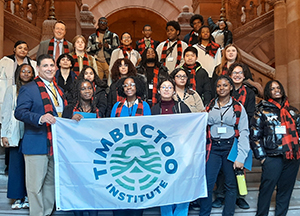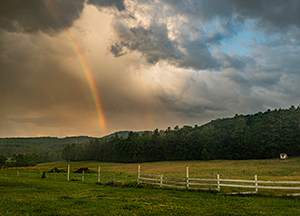
Oil Tank Car Junkyard Nearly Gone from R.R. Tracks to Tahawus
NEWCOMB, N.Y. – Only 24 remain of the more than 80 oil tanker railroad cars that had been stored on a track alongside the scenic Upper Hudson and Boreas rivers here, aerial photographs confirmed this week.
“We saw oil tankers leaving this unlicensed junkyard in April, but weren’t sure how many were still there,” said Adirondack Council Executive Director William C. Janeway, who flew over the site to photograph it last week. “We can see there are still 24 at the north end of the line, quite close to the former iron mine in Newcomb. The railroad company told the Warren County board of supervisors last week that the final 24 cars would be removed soon.
“Warren Buffett has removed his company’s rail cars. We thank the Warren County Board, Governor Andrew Cuomo, Attorney General Eric Schneiderman and Comptroller DiNapoli, all of whom contributed to this successful effort,” Janeway said. “We are pleased to have played a role in identifying and executing the steps needed to remove this junkyard and open this travel corridor to new, environmentally friendly possibilities.”
The state continues to press its complaint with the federal Surface Transportation Board. The Governor wants the STB to declare this portion of the track abandoned, with the Attorney General representing the Governor’s Adirondack Park Agency and Dept. of Environmental Conservation. Comptroller DiNapoli sent a letter to Buffett, urging him to remove the cars while the STB was considering its ruling.
If the STB rules in New York’s favor, the Iowa Pacific Holdings, LLC of Chicago would no longer have the right to move rail cars on to that portion of the tracks. Warren County may also moving to remove the company from the rest of the line inside the Adirondack Park (from the Village of Corinth to the hamlet of North Creek).
“There are a lot of options for the North Creek-to-Newcomb corridor that are better than an oil train junkyard,” Janeway said. “Local advocates have cited rail bikes, a hiking trail, or a new bicycle path as possibilities for reuse. If the condition of the tracks would allow it, commercial rail use could also be considered. Rail banking would allow the corridor to remain intact for future uses even if the rails are removed for a time.
“Our new railroad law attorney is Karyn Booth from Thompson Hine LLP, Washington, DC,” he said. “She will be helping us advise state and county officials on those options so the public can hold an informed debate on the future of the line.”
The Adirondack Council’s prior railroad law attorney Allison Fultz of Kaplan, Kirsch and Rockwell in Washington, DC was hired by Attorney General Schneiderman to work on the federal abandonment case before the STB.
Part of the 22-mile-long rail line from North Creek to Newcomb crosses the Adirondack Forest Preserve. It was built during World War II to remove ore for the production of titanium for ships, submarines and aircrafts. Federal permission to use the line expires in about 40 years.
Last year, Iowa Pacific refused to stop storing derelict oil tank cars in the Adirondacks when urged by Governor Cuomo. Instead, it had demanded millions of dollars to remove them and to give up its right to use the rail line.
In December, the Council praised Governor Cuomo and Attorney General Eric Schneiderman, when the state issued a cease-and-desist order to IHP and filed an initial petition with the federal Surface Transportation Board.
New York’s Adirondack Park is one of the world’s largest and oldest parks. It protects most of the wilderness and old-growth forest remaining in the Northeast. Its Forest Preserve has been protected as “forever wild” by the state Constitution since 1894. Although it is owned and administered by New York State, the entire 2.7-million-acre Adirondack Forest Preserve is further protected as a National Landmark.
The controversial junkyard was being assembled on a railroad that leads from the ski resort hamlet of North Creek to an early-19th Century iron mine 22 miles into the forest. The railroad terminates between the Hudson and Opalescent rivers at the old Tahawus mine, on the edge of the park’s famous High Peaks Wilderness Area.
Several miles of the railroad cross the Forest Preserve. The tracks also cross the Upper Hudson River, and run along the Boreas River, both of which are protected as “Scenic” under the NYS Wild, Scenic and Recreational Rivers Program.
The Adirondack Council is a privately funded not-for-profit organization whose mission is to ensure the ecological integrity and wild character of the Adirondack Park. The Council envisions a Park with clean water and clean air, comprised of core wilderness areas, surrounded by farms and working forests, as well as vibrant communities.
The Adirondack Council carries out its mission through research, education, advocacy and legal action. Adirondack Council members live in all 50 United States.
For more information:
John Sheehan
518-441-1340 cell
518-432-1770 office
FOR IMMEDIATE RELEASE: Tuesday, May 1, 2018




